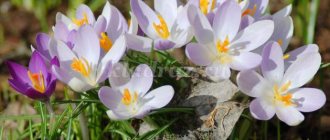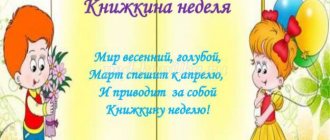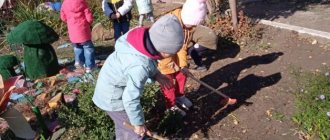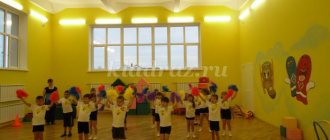Physical education project “Fun physical education” for older children
Order No. 867528
Best teaching practices in kindergarten
Physical education project “Fun physical education” for older children
Project type: informational and educational, long-term.
Project participants:
- Children of the older group;
- Parents of pupils;
- Educators;
Project implementation period: 4 months
Relevance of the project
Outdoor games are the most accessible and effective method of influencing a child with his active help. Thanks to games, the ordinary becomes unusual, and therefore especially attractive. The advantage of outdoor games over strictly dosed exercises is that the game is associated with initiative, imagination, creativity, is emotional, and stimulates motor activity. The game uses natural movements for the most part in an entertaining, unobtrusive manner.
“Outdoor play is a conscious, active activity of a child, characterized by accurate and timely completion of tasks related to the rules that are mandatory for all players.” The exciting content and emotional richness of the game encourage the child to make certain mental and physical efforts. The specificity of outdoor play is the child’s lightning-fast, instant response to the signal “Catch!”, “Run!”, “Stop!” etc. According to M. N. Zhukov, “outdoor play is a relatively independent activity of children, which satisfies the need for rest, entertainment, knowledge, and the development of spiritual and physical strength.”
Project goal: Development of motor activity and physical fitness through outdoor games
Tasks:
- Promote a child’s cognitive development by introducing him to outdoor games
- Help maintain a positive psycho-emotional state in children.
- Form and improve vital motor skills (walking, running, climbing, throwing, etc.). Satisfy children's need for movement
- To develop the basic physical qualities and motor abilities of children (strength, speed-strength, coordination, etc.).
- To develop the ability to follow the rules of outdoor games, showing resourcefulness, endurance, dexterity and independence.
- To instill in children an interest in physical education as an organized form of maximum manifestation of their motor and functional capabilities.
- Encourage motor creativity and varied play activities in children.
- To promote the development of self-control and self-esteem in the process of organizing various forms of physical activity.
- Promote the development of positive emotions, the ability to communicate with peers, mutual understanding and empathy.
Table 1 – Possible project risks
| № | Possible risk | Possible way to overcome |
| 1 | Lack of awareness among parents about the need to develop physical qualities in preschool age | Advisory and explanatory work of educators and specialists (consultations, memos, booklets, recommendations, master classes) |
| 2 | Passivity of parents in overcoming developmental problems of their child | Using different forms of work with parents to involve them in joint work |
Literature:
- Alyamovskaya V.G. How to raise a healthy child. M.: Arkti, 1993.
- Veraksa N.E. Child development in preschool childhood. M.: Mozaika-Sintez, 2010.
- Veraksa N.E., Komarova T.S., Vasilyeva M.A. From birth to school. M.: Mozaika-Sintez, 2010.
- Penzulaeva L.I. Health-improving gymnastics for children 3-7 years old. M.: Mozaika-Sintez, 2009.
Expected results of the project:
- Increasing the level of physical development of a preschooler. Development of physical qualities: agility, speed, endurance;
- Reduced morbidity. Strengthening children's health through outdoor games;
- Instilling interest in a healthy lifestyle;
- Children’s ability to play outdoor games;
- Development of motor activity of children;
- Uniting the children's team;
- Enrichment of children's vocabulary (counting books, new words for children).
Project outcome
- Children have developed an interest in a healthy lifestyle.
- Children have formed ideas about sports, outdoor games, a healthy lifestyle, and health.
- Children learned to play and follow the rules in outdoor games.
- Children's physical activity has increased.
- Social and communicative skills of communication between children have been formed.
Project. Organization of physical education and health activities for older children
Practice-oriented project. Organization of physical education and recreational activities with children of senior preschool age Author: Davletbaeva Svetlana Rafitovna Position and place of work: teacher of MDOBU kindergarten in the village of Tashkinovo, Neftekamsk Description of the material: this material will be useful for teachers, physical education instructors working in a small kindergarten with groups of different ages. Physical education and health work in kindergarten is shown using the example of senior preschool age children. Relevance “Health for every person comes from physical education, hardening, and a healthy lifestyle!” – these words belong to the great Russian surgeon, scientist, academician N.M. Amosov. The World Health Organization (WHO) considers health as a positive state that characterizes the person as a whole, and defines it as a state of complete physical, spiritual (mental) and social well-being, and not just the absence of disease and disability. In 2000, 189 UN member countries gathered at the Millennium Summit and put forward 8 goals and 18 tasks for the new millennium, the implementation of which by the agreed date (2015) should change the lives of the peoples of the world. The fourth, fifth and sixth goals relate to health issues, including reproductive health of the population (V.V. Bodrova, E.N. Bodrova, 2005). In the conditions of socio-economic instability in Russia during perestroika, stable negative trends have formed in the health of children and adolescents: - the prevalence of risk factors affecting the deterioration of health and development; - increase in morbidity and disability. The intensity of deterioration in the quality of health of children and adolescents is 3.5 times higher than that of the adult population (I.V. Zhuravleva, 2002). The health of children in Russia is especially important given the significant decline in the country's population. At the beginning of 1991, the population of Russia was more than 290 million; by 2014, the population had decreased to approximately 144 million. Director of the Scientific Center for Children's Health of the Russian Academy of Medical Sciences, academician of the Russian Academy of Medical Sciences A.A. Baranov (2006) argues that only the generation that goes to kindergarten today can correct the demographic situation in modern Russia. Nikolaeva Elena Ivanovna – Doctor of Biological Sciences, Professor of the Department of Psychology and Psychophysiology of the Child, Russian State Pedagogical University. A.I. Herzen in his book (2014) writes: “Obviously, in order for children to be healthy in a situation of widespread morbidity at birth, it is necessary not so much to maintain health (which is practically non-existent), but to form it. Talking about health conservation now is ineffective. It is necessary to raise the question of conscious health formation among the population with poor health. It is necessary to start working with children at the kindergarten level in order to create an attitude towards a healthy lifestyle and responsibility for their own health as early as possible.” The concept of modernization of Russian education provides for the creation of conditions for improving the quality of general education and for these purposes, along with other measures, involves the creation in educational organizations of conditions for preserving and strengthening the health of students. Analysis of the physical development of children, observations, conversations, questioning of parents on the health status of children, showed that in children attending kindergarten. Tashkinovo also has a tendency to deteriorate health. We asked ourselves the question: how to teach children to take care of their health, starting in kindergarten and for the rest of their lives? Preschool workers were faced with a difficult and difficult task - to structure their work so that it not only met the needs of society, but also to organize an integral system of physical education and health work for an individual teacher with an individual child and an entire teaching staff with a group of children. However, it is known that solving educational problems, developing a sufficient level of children’s knowledge and skills, and bringing them into compliance with the Federal State Educational Standard in a mixed-age group of a small kindergarten causes some difficulties for the teacher. Such as: • the main methodological literature on preschool education is designed for institutions with preschool groups of the same age; • in rural areas, the low educational and cultural level of parents does not allow for the proper development of children; • the over-employment of most parents in their personal households does not leave them time to communicate and engage with their children; • the low material support of many rural families does not allow them to satisfy the basic cultural needs of the child: buy books, games and toys, sports equipment, take children on trips to the city - to sports clubs and sections, to choreographic studios, to theaters, museums; • remoteness from cultural centers, isolation, autonomy. The limited space, a certain paucity of opportunities for entertainment and recreation, opens up on the other side, namely, if an event is being prepared in a club, school, kindergarten, then the entire population of the village, regardless of age, will be indispensable participants, interested grateful spectators. Life experience and observations show that the rural environment has undeniable advantages over the city in nurturing positive emotions, kindness, hard work, hardening, and developing a child’s physical activity. Staying in the fresh air, getting to know the surrounding nature: forest, ravines, ponds, springs, rivers, villages, meadow grasses - all these factors, when used skillfully, have a beneficial effect on the emotional, intellectual, and physical development of the child. The contradictions between the possibilities of social and natural potential became the basis for the development of the project. The kindergarten has accumulated a wealth of experience in physical education and health work, creating the most favorable conditions for strengthening the health and harmonious physical development of each child in the conditions of using a favorable macroenvironment. Health-saving and health-forming technologies have been widely introduced into work practice. There are many reasons for changing the content of physical education and health work in a preschool organization. But we consider the following to be the most important: 1. The need for a person to develop, from childhood, the position of a creator in relation to his own health and the health of others; 2. The need to overcome highly specialized approaches in organizing health activities and physical education. All of the above shows the relevance of the problem of improving children's health. The goal of the project is to systematize physical education and health activities in a preschool organization with the involvement of all participants in the educational process to preserve and strengthen the health of students, reduce morbidity, and introduce children and parents to physical education and a healthy lifestyle. Project objectives: • Studying the work experience of scientists - didactics and advanced teachers on this problem; • Protecting and strengthening the physical and mental health of children, including emotional well-being; • Formation and development of motor skills in children; • Promoting proper physical development and improving performance in children; • Instilling the skills of correct posture, hygiene skills, mastering knowledge about your body, about health as one of the main values of life; • Formation of children's ideas about the regime, activity and rest. • Develop in children the habit of daily physical exercise as a need for physical perfection; • Providing psychological and pedagogical support for the family and increasing the competence of parents in matters of protecting and promoting the health of children. Hypothesis. The health of children will be maintained, strengthened and developed, and physical qualities will be effectively improved, provided that a system of working with children and their parents on physical education and health improvement is developed using innovative health-saving technologies, new active forms of working with parents to form healthy habits way of life. Project type: practice-oriented. Project duration : the project is designed for 2 years (2014-2015). Project participants: children, teachers and employees of the kindergarten in the village of Tashkinovo, parents (legal representatives of the pupils). Form of implementation : educational activities, independent activities of children and interaction with their families. Expected result: In children: • maintaining and strengthening the physical health of children; • increasing the efficiency of the physical education process. For parents: • joint participation with children in physical education and recreational activities;
• increasing competence in matters of physical development of children; • use of health-saving technologies in the family For teachers: • development of methodological and practical material for the project; • increasing competence in physical education and health improvement using innovative technologies; • systematization of work on healthy lifestyle in an educational organization; • generalization and dissemination of work results among teaching staff of preschool educational institutions; Resources 1. Scientific and methodological base. • Law “On Education in the Russian Federation” dated December 29, 2012 No. 273 - Federal Law; • Federal state educational standard for preschool education (Order of the Ministry of Education and Science of Russia dated October 17, 2013 No. 1155). • The procedure for organizing and implementing educational activities for basic general education programs - educational programs for preschool education, August 30, 2013 No. 1014; • State program of the Russian Federation “Development of Education” for 2013-2020 (approved by order of the Government of the Russian Federation dated May 15, 2013 No. 792 - r); • Development program for MDOBU kindergarten. Tashkinovo 2014-2016; • Sanitary and epidemiological requirements for the design, content and organization of the operating hours of preschool educational organizations; • The concept of preschool education (approved by the decision of the board of the USSR State Committee for Public Education on June 16, 1989 N 7/1); • Charter of the preschool institution, local acts. 2. Human resources, children, parents (legal representatives) . 3.Material and technical base To implement the educational process in the preschool educational institution there are: - 3 group rooms with a developing subject-spatial environment that corresponds to the age characteristics of the pupils: - a physical education and music hall; — music director’s office; - methodological room; — a sports ground on the territory of the kindergarten; — teaching aids; - children's and methodological literature. 4.Modern information and technical base: - computer connected to the Internet, e-mail; - music Center; — tape recorders in each preschool group; - TV; - camcorder; — copying and duplicating equipment; - digital camera; - video projector. Developing subject-spatial environment of preschool education (Schemes) Project implementation stages: Preparatory stage: • Study and use of literature, materials and documentation on the project topic. • Analysis of the state of the developing subject-spatial environment of preschool educational institutions; • Study (questionnaire) of the needs of parents; • Monitoring of children's physical fitness; • Increasing the professional competence of teachers, mastering health-saving technologies; • Collection of information and necessary material for the implementation of the project. Main stage: Implementation of the project in various types of activities. Final stage: • Summing up. • Creation of a photo report on the project. • Special issue of the parent newspaper on physical education “Zdorovyachok” Project implementation plan Table Conclusion The use of physical education, hardening and a number of other non-medicinal means of health improvement in the health-improving work of the kindergarten produces positive results. Working in accordance with the requirements of the educational program of the MDOBU kindergarten in the village of Tashkinovo, developed on the basis of the program of N.E. Veraksa, T.S. Komarova, M.A. Vasilyeva “From birth to school” and using health-saving technologies in our work, we achieved the following results: - positive dynamics of health status, - reduction in morbidity levels. Thus, the use of health-saving pedagogical technologies in work increases the effectiveness of the educational process, forms in teachers and parents value orientations for preserving and strengthening the health of children, and in the child a strong motivation for a healthy lifestyle. And we achieved the following results: — there is a positive trend in health status, a decrease in the incidence rate. In the 2014-2015 academic year, attendance in all preschool groups was more than 80%. — the level of children’s physical development, physical performance, and general endurance has increased. Monitoring of physical activity this academic year amounted to more than 74% (compared to last year - 70%). Monitoring of the educational program of the preschool organization showed that our students know the basics of a healthy lifestyle, are conscious of their health and know how to use available ways to strengthen it. The work of preschool teachers in the system has revealed positive trends towards the formation of interest in a healthy lifestyle among preschoolers. Action plan to minimize risks Probable risks Shortage of qualified personnel: - Insufficient orientation of teaching staff in modern health-preserving and health-forming technologies. — Lack of formation of aspirations among individual teachers of professional culture in matters of health conservation. — The main methodological literature on preschool education is designed for preschool groups of the same age. — Weakness of the material and technical base for equipping a developing subject-spatial environment, including physical education equipment. — Incompetence of parents in matters of education, development, and upbringing of their child. - Most parents are overly busy in the household. — Limited capabilities of families, both in material terms and in territorial distance from urban centers of physical education and sports. Measures to minimize risk - Completion of advanced training courses. — Introduction of incentive and financial incentive mechanisms. — Increasing the professional competence of teachers, mastering health-saving technologies by studying, generalizing and disseminating advanced pedagogical experience. — Introduction of additional educational paid services. — Attracting sponsorship, participation in grandees. — Competent implementation of the project, updating its content, expanding the educational and methodological base, developing variable educational programs taking into account the specifics of the work of a rural kindergarten. — Development of partnerships with children’s parents. — Systematic and systematic methodical work with participants in the physical education and health process, — Timely adjustment of direction to meet the interests and capabilities of children and the needs of parents. Project product 1. Construction of “Health Paths” on the sports ground. 2. Special issue of the parent newspaper on physical education “Zdorovyachok”. 3. Creation of card files in kindergarten groups - sports, outdoor games, finger games, morning exercises, invigorating exercises. 4. Creation of a photo report on the project.
Literature: Regulatory: 1. Law “On Education in the Russian Federation” dated December 29, 2012 No. 273 - Federal Law. 2. Federal state educational standard for preschool education (Order of the Ministry of Education and Science of Russia dated October 17, 2013 No. 1155). 3. Sanitary and epidemiological requirements for the design, content and organization of the operating mode of preschool educational organizations. 4. The concept of preschool education (approved by the decision of the board of the USSR State Committee for Public Education on June 16, 1989 N 7/1). Main: 1. Alyabyeva. E.A. Non-boring gymnastics. Themed morning exercises for children 5-7 years old. – 2nd ed., rev. And additional – M.: TC Sfera, 2015. – 144 p. – (Raising children healthy). 2. Gavryuchina L.V. Health-saving technologies in preschool educational institutions: Methodological manual. - M.: TC Sfera, 2008. - 160 p. (Healthy baby). 3. Preschool education in the XXI century [Text] // Collection of materials of the All-Russian scientific conference with international participation. Ufa, April 26, 2013. –Ufa: BSPU Publishing House, 2013. 4. Nikolaeva E.I., Fedoruk V.I., Zakharina E.Yu. Health preservation and health formation in a kindergarten: method. Manual - St. Petersburg: Publishing House "Childhood - Press", 2014. - 240 p. 5. Penzulaeva L.I. Health-improving gymnastics. Sets of exercises. For classes with children 3-7 years old. – M.: MOSAIC-SYNTHESIS, 2014.-128 p. 6. Stepanenko E.Ya. Collection of outdoor games. For classes with children 2-7 years old - M.: MOSAIKA - SYNTHESIS, 2015. - 144 p. 7. Report on the development of human potential in the Republic of Bashkortostan. Family and human development. Prepared by the Center for the Study of Human Potential of the Institute of Socio-Political and Legal Studies of the Republic of Bashkortostan and the Bashkir Branch of the Institute of Sociology of the Russian Academy of Sciences with the support of the Government of the Republic of Bashkortostan, the United Nations Development Program (UNDP) in the Russian Federation and the United Nations Population Fund (UNFPA) Ufa - 2013 file:/ //F:/Bashkortostan_doklad_2013.pdf
We recommend watching:
A project in a kindergarten for older preschoolers 5-7 years old on legal topics. Developmental environment of an educational institution. Physical education and recreational leisure in the middle-preparatory group. Scenario Summary of physical education and gaming leisure according to traffic rules for the preparatory group
Similar articles:
Project for children of the senior group “Our cheerful garden”



